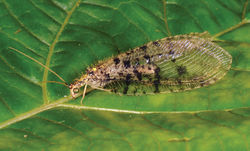Gryposmylus
| Notice: | This page is derived from the original publication listed below, whose author(s) should always be credited. Further contributors may edit and improve the content of this page and, consequently, need to be credited as well (see page history). Any assessment of factual correctness requires a careful review of the original article as well as of subsequent contributions.
If you are uncertain whether your planned contribution is correct or not, we suggest that you use the associated discussion page instead of editing the page directly. This page should be cited as follows (rationale):
Citation formats to copy and paste
BibTeX: @article{Winterton2016ZooKeys, RIS/ Endnote: TY - JOUR Wikipedia/ Citizendium: <ref name="Winterton2016ZooKeys">{{Citation See also the citation download page at the journal. |
Ordo: Neuroptera
Familia: Osmylidae
Name
Gryposmylus Krüger, 1913: 32. – Wikispecies link – Pensoft Profile
Type species
Chrysopa pubicosta Walker 1860[1]: 183, original designation.
Diagnosis
Forewing length 15–18 mm. Antennae much shorter than forewing length; head with posterior genal area relatively wide; prothorax length subequal to width; female forecoxa lacking pedicellate setae or anterior processes; wing ovoid, not falcate along posterior margin; costal area broad basally with basal crossveins arranged radially, costal crossveins simple with occasional forking; interlinking crossveins absent from entire wing margin; wing venation with relatively few crossveins; two gradate series well defined, divergent in orientation; single basal subcostal crossvein present; forewing with seven branches of Rs present, basal branch of Rs diverging close to origin of Rs on R1; forewing M vein branching in proximal half of wing, basal to origin of basal branch of Rs; hind wing CuP as a single vein branching just before wing margin; male genitalia with gonarcus narrowly arched medially and apilose, anterior arms of gonarcus (=baculum) present, non-articulated; parameres present, ends fused anteriorly and forming an arch-shape; entoprocesses narrow, spatulate distally and curved dorsally; male tergites 8 and 9 as separate sclerites, scent glands absent; female genitalia with sternite 8 positioned posteriorly, small and knob-like (=subgenitale), hollowed depression in the membrane immediately posterior to sternite 7; sternite 7 unmodified; spermatheca as single lobe, folded onto itself; spermathecal duct greatly elongate and coiled around spermatheca.
Included species
Gryposmylus pubicosta (Walker); Gryposmylus pennyi sp. n.
Comments
Gryposmylus is a distinctive Oriental genus that is the putative sister genus of Lysmus. Both genera have the basal branch of forewing vein Rs diverging close to the origin of Rs on R. In Gryposmylus forewing vein M forks basally, or equal with, the origin of the basal branch of Rs, while in Lysmus this fork is distal to the origin of the basal Rs branch. The costal margin of Gryposmylus is wider basally than in all other Protosmylinae genera, and the basal 7–8 costal crossveins are arranged in a slight radiating pattern, while in other genera they are usually parallel, or only the basal 2-3 veins are radially oriented. Also in Gryposmylus the forewing gradate series is generally divergent in orientation, while in other Protosmylinae genera they are subparallel. There is some variation among individuals in both Gryposmylus and Lysmus and the distinction of the genera is not consistently defined. At this time we maintain them as separate genera until more species are known and the limits of this variation are known.
Key to species of Gryposmylus
Taxon Treatment
- Winterton, S; Wang, Y; 2016: Revision of the genus Gryposmylus Krüger, 1913 (Neuroptera, Osmylidae) with a remarkable example of convergence in wing disruptive patterning ZooKeys, (617): 31-45. doi
Images
|
Other References
- ↑ Walker F (1860) Characters of undescribed Neuroptera in the collection of W. W. Saunders. Transactions of the [Royal] Entomological Society of London 10(5): 176–199. doi: 10.1111/j.1365-2311.1860.tb01844.x



